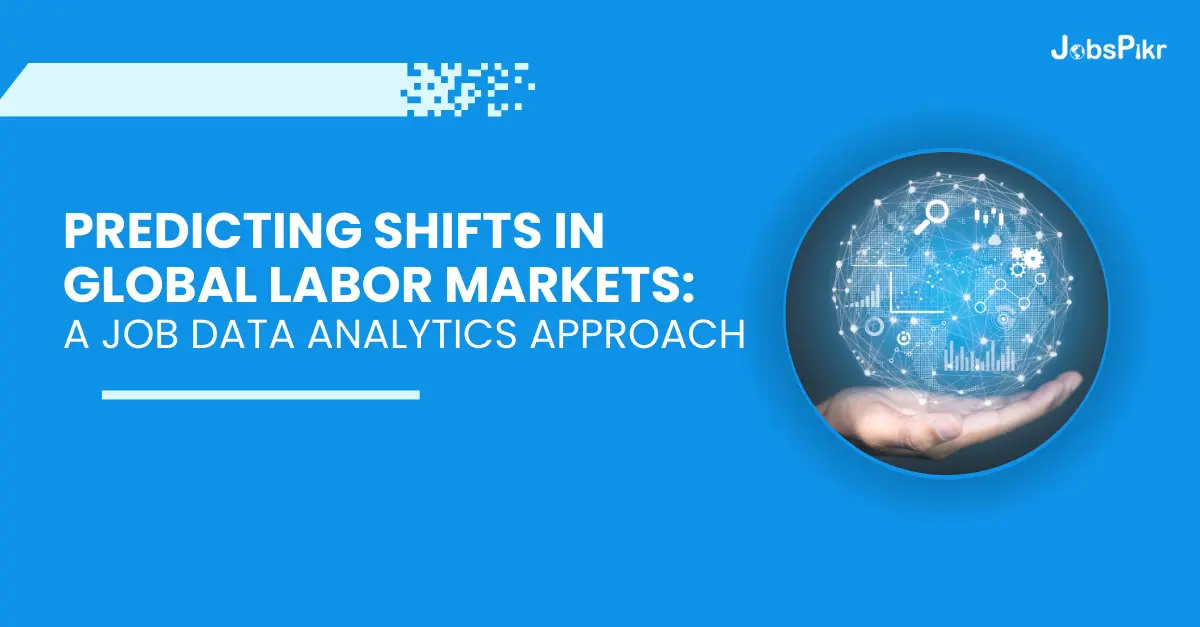From multinational corporations to small startups, businesses rely on a skilled and adaptable workforce to thrive in today’s competitive landscape. However, the dynamics of the labor market are constantly evolving. Because of this, the ability to predict changes in the global labor market is not just advantageous—it’s a must to survive in an ever-changing business landscape.
Consider this: Your company suddenly faces a shortage of skilled workers in critical areas. If the market has a short supply of labor with these important skills, your company will have to pay high salaries to attract good talent. The consequences of such unexpected labor market shifts can be significant. It can impact everything from hiring strategies to operational efficiency and overall business performance.
Predicting changes in the global labor market helps with talent management, business expansion, policy development, and more. But for this, you need reliable tools that offer accurate job data analytics with powerful insights into labor market dynamics. Job data analytics involves analyzing vast amounts of job-related information, such as job postings, skills demand, and hiring trends, to uncover valuable insights.
In this blog, we’ll explore how a job data-driven approach can empower businesses and policymakers to anticipate workforce trends, adapt strategies, and thrive in the face of uncertainty.
What Factors Determine The Change In The Job Data Analytics?
There are several factors that influence changes in the labor market. Understanding these factors and their interplay is crucial for predicting and adapting to shifts in the labor market landscape. Let’s look at these in brief:
- Technological Advancements: Automation, AI, ML, and other advancements in tech can lead to the creation or elimination of certain jobs.
- Economic Conditions: When there are fluctuations in the economy — job availability, wages, and the overall demand for labor change significantly.
- Globalization: When companies start outsourcing their work to other countries or move their operations to another location, it can influence all the associated labor markets.
- Cyclical & Structural Changes: Seasonal hiring patterns are also a major reason for changes in global labor markets. This also includes shifts in industry composition or business models.
- Government Policies & Regulations: Minimum wage laws, immigration policies, and other governmental labor market regulations shape the job market dynamics.
- Industry Trends: New emerging industries can influence the distribution of jobs across sectors and regions. This usually happens because of shifts in consumer preferences and market demands.
Now that we know how the relationship between demand and supply of labor changes, let’s look at how labor market data can empower you to manage these changes.
Forecasting with Precision:
One of the most significant benefits of job data analytics is its ability to forecast labor market trends with precision. Job posting data helps analysts identify emerging job roles and industries, allowing businesses to prepare their workforce accordingly.
For instance, suppose job postings for renewable energy engineers are on the rise. This insight suggests a growing demand for renewable energy solutions. It also indicates a shift in the labor market towards sustainability. Armed with this information, businesses can invest in training programs to upskill their employees or adjust their hiring strategies to attract talent in this field.
Adapting Strategies in Real Time:
Adaptability is the key to staying relevant in any industry. Consider a scenario where data reveals a decline in job postings for traditional manufacturing roles but a surge in demand for automation specialists. This insight signals a fundamental shift towards automation in the manufacturing sector.
Such job data analytics empower businesses and policymakers to adapt their strategies in real-time to meet changing workforce needs. In this scenario, businesses can respond by investing in automation technologies and re-training their workforce to thrive in this new environment.
Enhancing Policies:
Policymakers also stand to benefit significantly from job data analytics. By leveraging insights into labor market trends, governments can formulate policies that support economic growth and address skill shortages.
For example, if current job data indicates a shortage of healthcare professionals in a certain region, a new policy that incentivizes training programs can be introduced to fill the gap. Similarly, it can help in tailoring education and training initiatives accordingly.
JobsPikr, a revolutionary data platform, is at the forefront of this revolution. It provides comprehensive labor market trend analysis capabilities that are reshaping how we understand and navigate the workforce landscape. What sets JobsPikr apart is its utilization of powerful ML models to extract valuable insights hidden within job descriptions. This brings forth enriched data that is both comprehensive and accurate.
How To Use Global Labor Market Data To Your Benefit your Job Data Analytics
- Strategic Planning: By gaining insights into changes in demand for specific skills or industries, you can align your business’s hiring, training, and talent development strategies.
- Talent Acquisition and Retention: By identifying emerging skill requirements and salary trends, your business can modify its recruitment and retention strategies to remain competitive in the talent marketplace.
- Cost Management: By forecasting future labor supply and demand, your business can streamline its hiring processes and optimize workforce deployment to reduce unnecessary expenses.
- Risk Mitigation: By anticipating factors such as tech advancements, economic downturns, or changes in regulatory environments, your business can proactively prepare for potential challenges and minimize negative impacts on its operations.
- Business Expansion and Investment: By identifying regions or industries experiencing growth opportunities, you can allocate business resources strategically and enter new markets. Investing in emerging technologies helps capitalize on evolving trends and maximize ROI.
- Social Impact: By identifying areas with high rates of unemployment, underemployment, or skill mismatches, stakeholders can develop targeted interventions to support vulnerable populations. It can also be used to promote workforce diversity and reduce socio-economic disparities.
In conclusion, job data analytics is a powerful tool for indicating upcoming transformations in global labor markets. By harnessing these job data insights, businesses can adapt their strategies and seize new opportunities. Likewise, policymakers can make informed decisions to support a thriving and dynamic workforce.
JobsPikr stands out as a leading platform offering detailed analysis and up-to-date information on global labor market trends. With access to a vast database comprising over 500 million jobs, JobsPikr overcomes prevailing challenges faced by businesses in gathering accurate and timely labor market data. Reach out to the experts at JobsPikr today to schedule a demo.




